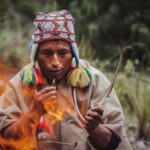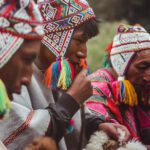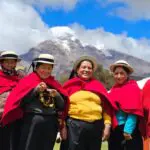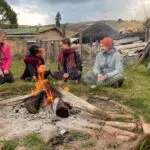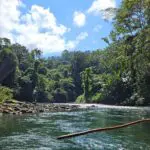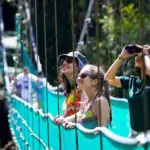Take a look at our latest article on Machu Picchu (2023).
Visiting Machu Picchu nowadays implies a little more planning than usual (previous to 2020). But things have already started to get tricky in 2007, when the archaeological site was appointed one of the 7 Modern World Wonders. Another event that added to the complexness of visiting the site was the 100th anniversary (in 2011) of the discovery of Machu Picchu by Hiram Bingham in 1911. It has transformed the place into an even stronger magnet for the crowds and instagrammers trying to get the perfect shot at these marvellous ruins. Of course, too many visitors can be very harmful to a site such as Machu Picchu. No wonder at some point, it was on the verge of being declared heritage in danger by UNESCO. To protect the site, Peru started to work on sustainable strategies to apply to Machu Picchu in 2017. Such a strategy comes with rules and restrictions. Although the latter are very important in terms of conservation, they can render a visit to Machu Picchu quite complicated.
This being said, let us help you resolve the complex issue of visiting Machu Picchu. We’ll do that one step at a time.
Entrance timetables for Machu Picchu
There are nine time slots (one every hour) to enter the citadel, the first one being at 6 AM and the last one at 2 PM. At 3 PM the entry is closed.
The least busy moments are the last 3 slots (starting from 12 AM), followed by the first 3 (from 6 to 8 AM), while the busiest are the ones from (9 to 11 AM).
Here is an example of a typical situation of ticket availability on any given day (the blue numbers represent the available tickets left out of 300 in total ).

And the following is what happens if you wait until the very last minute to buy your ticket.

Note: the absolute maximum capacity of Machu Picchu (let’s call it MaPi from now on) per day is 4044 people considering those who access by the Inca Trail (July 2022).
Another aspect to keep in mind is that the three main monuments of the citadel can only be visited at certain moment of the day:
- The Intiwatana Pyramid is open from 7 to 10 AM
- The Condor Temple is open from 10 AM to 13 PM
- The Sun Temple is open from 13 to 16 PM

Due to these time slots, you might want to plan your visit according to your main interests. Know that good planning can allow you to access two out of the three main monuments. To do that you should choose one of the time slots in the middle (which, however, are also the busiest as seen before). For example: if you enter MaPi at 9 AM, you will be able to see Intiwatana before it closes (10 AM) and then continue your way to Condor Temple, which opens at 10 AM.
This level of planning is certainly tricky, but the regulations at MaPi are put in place to limit the degradation of the site caused by thousands of daily visitors wanting to be all over the place during long periods of time. So to respect the site and the willingness to preserve it, we invite you to accept that you will see certain ruins in MaPi but not absolutely everything. Take it easy and ask your guide what your best options are in the given circumstances.
Understanding the circuits or fix routes in Machu Picchu
Visiting MaPi should be an enjoyable experience. To most people, it is the one and only visit of their lifetime, so you better make sure you will have the best day you possibly could (excluding of course unpredictable bad weather or other unfortunate contingencies). To enhance your experience, it is important not only to choose the right time slot, but also the right circuit.
The following 4 circuits are the ones designed for visiting the citadel only (simple ticket). But #3 and #4 are the ones that people wanting to climb Machu Picchu Mountain or Wayna (or Huayna) Picchu Mountain should follow (this requires buying different tickets of higher cost. And only 400 and 200 places available respectively).
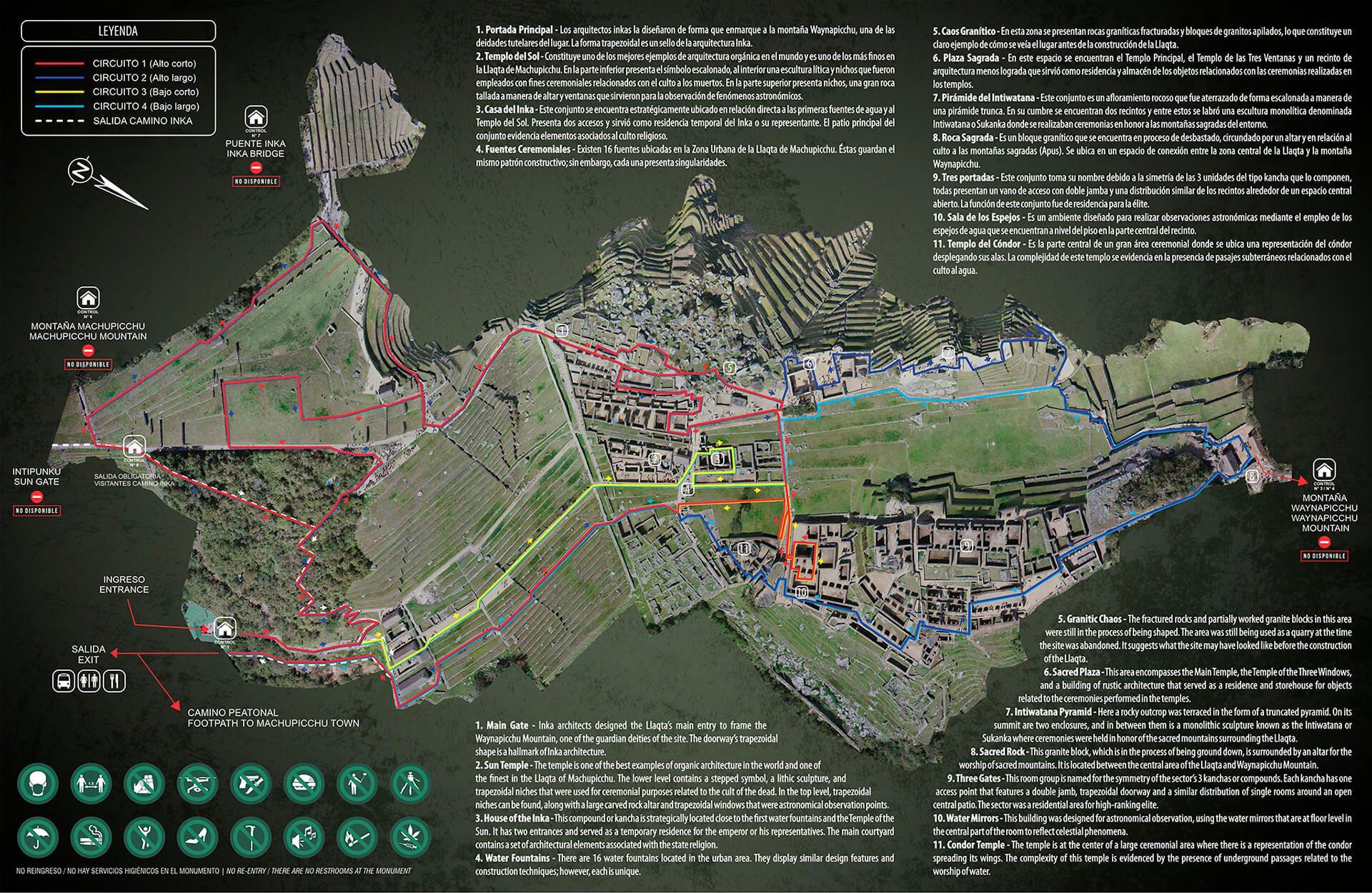

Pros
- Gives access to the classic lookout point for great scenic views.
- Great during the less-visited times, as explained before.
Cons
- Doesn’t give access to almost half of the complex, where the Sacred Plaza, Intiwatana Pyramid, Sacred Rock, Three Gates and Condor Temple are located.
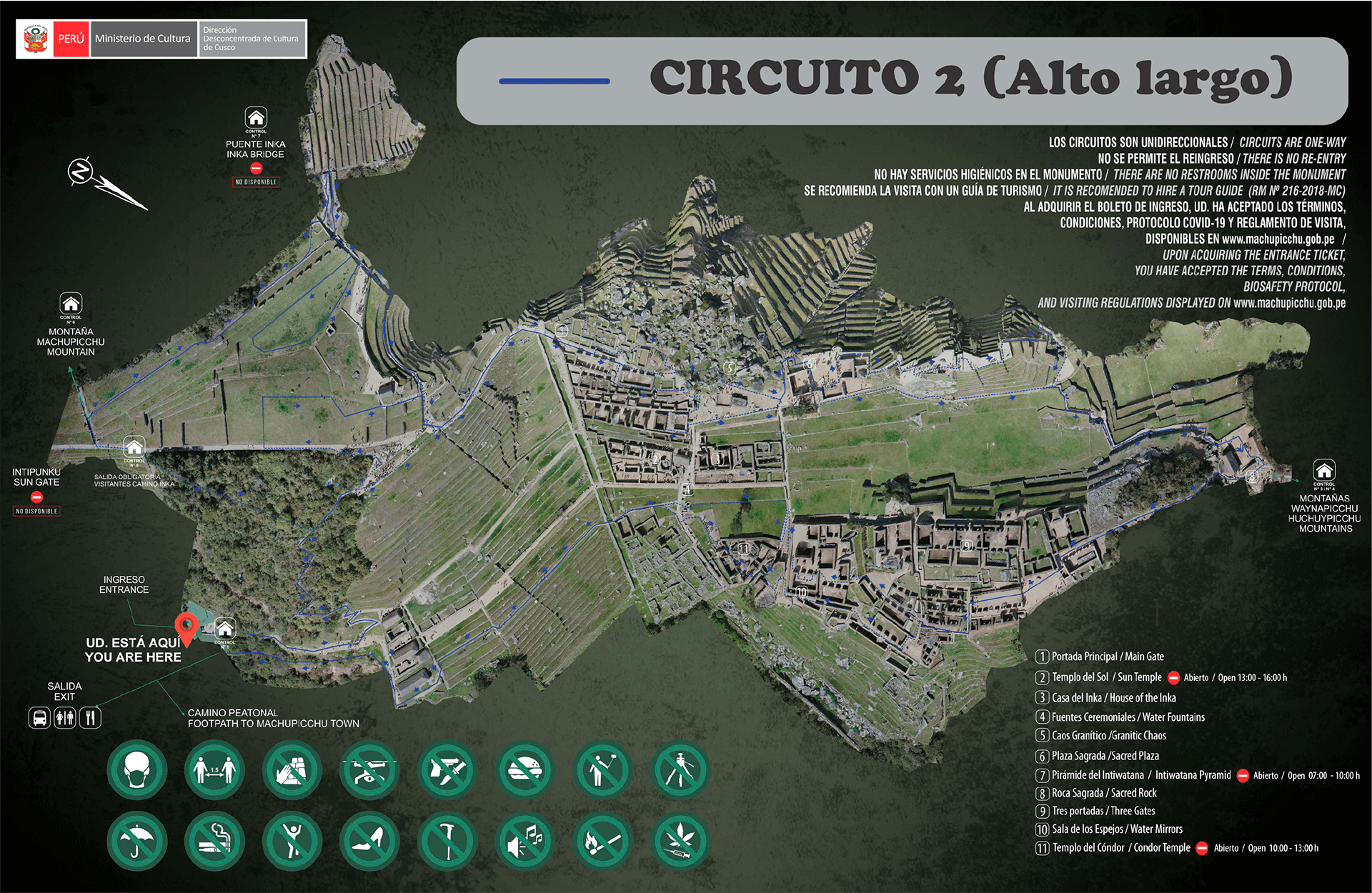
Pros
- Gives access to the classic lookout point for great scenic views.
- Great during the less-visited times, as explained before.
- Probably the best circuit of all.
Cons
- No cons to list here.
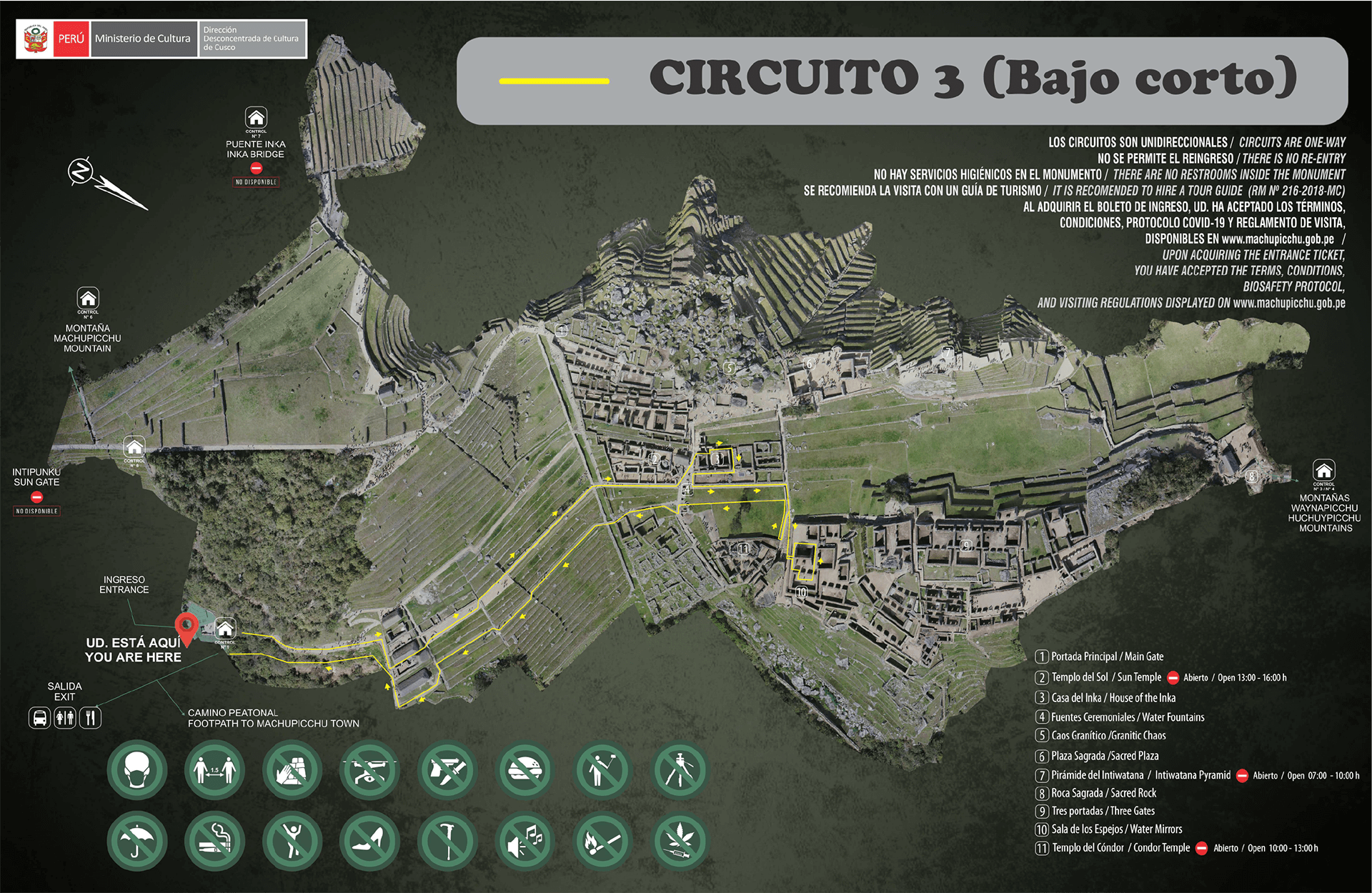
Pros
- This is a circuit designed for people with physical limitations (and/or using wheelchairs). There is no need to climb or descend.
Cons
- Very limited: it doesn’t give access to the classic lookout point nor many other monuments of the site.
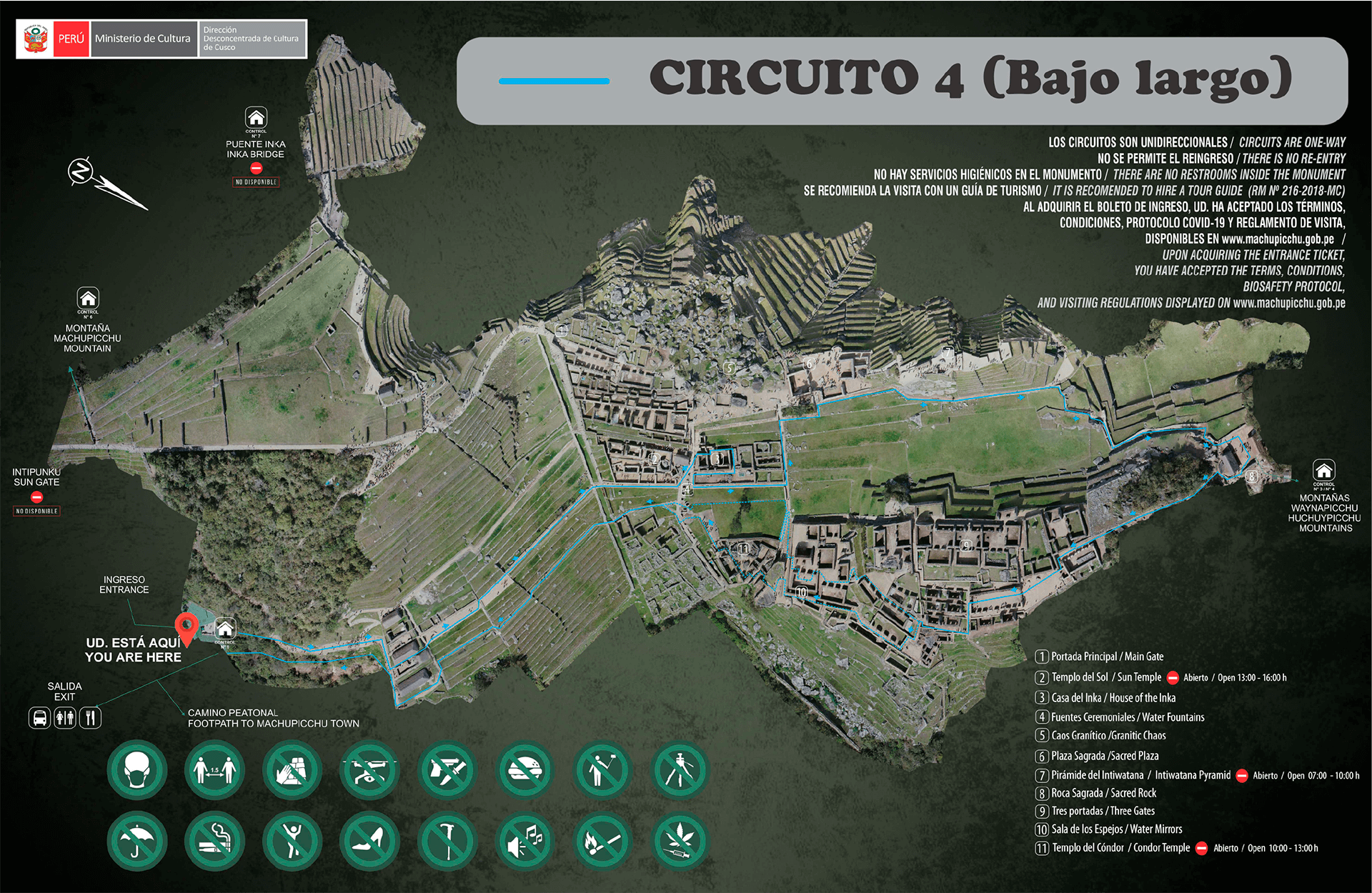
Pros
- Good for those who cannot (or don’t want to) climb a lot but still want to have a more or less comprehensive visit of the citadel.
Cons
- Doesn’t give access to the classic lookout point and you won’t enter through the main gate (the one in the header image).
Protocol for entering the citadel of Machu Picchu :
- Check if you are wearing a mask (and correct fitting).
- Temperature check (if above 37.5°C, you will be moved to the isolation area for observation and further checking).
- Pass through disinfection and health area. This means hand sanitizing and shoe soles disinfection.
- Ticket barcode scan (suggested in digital format instead of printed copy).
- You will be requested to hand-in the Contractor and Visitor Health Declaration Form “Formato de Declaración de Salud de Contratistas y Visitantes (Anexo 3)“
- A random check of identity documents.
- Control of compliance with the maximum number of visitors per group (8 including the guide).
- You will told about the maximum length of stay. Normally 4 hours, but some exceptions to the rule can apply.
Alternative routes and ticket types for Machu Picchu
Here you can see the three mountains of Machu Picchu that you can visit, pinned with orange icons.
To climb Wayna Picchu and Machu Picchu mountains, you must buy not only the ticket to the citadel itself but also specific types of tickets granting access to each of the two mountains separately. Here is a comparison of the options:
The most popular choice is Wayna Picchu mountain, but this route only allows 200 spaces per day distributed in four time-slots from 6 to 7 AM, from 8 to 9 AM, from 10 to 11 AM, and from 12 M to 1 PM.
This climb is not for the heart-fainted and is of intermediate to high difficulty.
By purchasing this (more expensive) ticket, you agree to do only circuit #4 of the ones explained above.
We tend to recommed the Machu Picchu mountain, allowing 400 spaces per day distributed in two time-slots from 7 to 8 AM and from 8 to 9 AM.
It requires less physical effort and it isn’t as scary as the Wayna Picchu climb can be for the ones with vertigo.
By purchasing this (more expensive) ticket, you agree to do only circuit #3 of the ones explained above and that you will do it only after the climb.
There is a third option to access (this involves no climbing) Huchuy Picchu mountain (but as huchuy means little, you might guess that this is less attractive, which we believe is true).
There are 200 tickets available per day distributed in eight time-slots every hour from 7 to 2 PM (you have an hour to visit)
By purchasing this (same value) ticket, you agree to do only circuit #4 of the ones explained above.
Visiting the popular Inca Bridge is now possible (since September 2022) when taking circuits 1 or 2.
But the chance of visiting the Sun Gate remains unavailable.
Prohibitions
During your visit to MaPi it is prohibited to:
- Carry backpacks, bags or purses larger than 40x35x20 cm (16x14x8 inches).
- Enter with food or kitchenware, i.e. plates, cutlery, thermoses, etc.
- Enter with any illegal substance or be under the influence of any substance.
- Enter with any type of alcohol or under its influence.
- Enter with umbrellas, walking sticks, portable chairs, tripods, monopods, selfie sticks or other photography/film stabilization accessories.
- Enter with animals, except guide dogs.
- Feed domestic or wild animals.
- Enter with any type of aerosol.
- Deface, alter or leave any type of graffiti.
- Enter with any type of musical instrument, megaphone or speakers.
- Make loud or disturbing noises (scream, whistle, clap, sing, etc).
- Use virtual apps in narrow paths or outside designated explanation areas.
- Enter with heels or hard-sole shoes.
- Access with baby strollers.
- Enter with knives or weapons of any kind.
- Enter with banners, posters or other objects of this type, clothing intended for advertising purposes, and costumes, among others.
- Film or photograph for advertising purposes.
- Generate turmoil, undress, lie down, run and/or jump.
- Climb or lean on walls and/or structures. Touch, extract or move lithic elements such as rocks and stonework.
- Disturb, collect or remove flora or fauna.
- Carry out activities that distort the sacredness of the monument; such as fashion shows, dances, social commitments, obscene acts contrary to morality and good manners, and perform any kind of activity that implies the impairment or deterioration of the monument, its natural environment and/or facilities.
- Smoke or vape, or start a fire of any kind.
- Litter.
- Stray from the established circuits/routes.
- Sell or trade inside the monument and surrounding areas, until Puente Ruinas.
- Fly over with paragliders, drones or any type of craft.
Performing acts or entering with objects prohibited in this list will generate the immediate expulsion of the visitor without reimbursement and the start of legal actions if necessary. The park guards of the Ministry of Culture and the agents of the National Police are the authority within the monument’s premises.
What to take for the visit?
- Good shoes, consider that there could be mud and/or wet rocks and that you also want your ankles to have good support during your walk or climb to some of the mountains.
- If it’s the rainy season (November-April) there will most likely be some precipitation, and even if it’s not rainy season, you want to be alert. You never know when there will be wet conditions, therefore you will want to bring a light or heavy raincoat.
- If you need a walking stick, it must always have a rubber tip.
- Solar protection: everything you find to be necessary and enough, along with sunscreen (hat/cap, sunglasses, long sleeves and pants, others)
- Hydration for the maximum length of the visit (5 hours tops) and snacks in reusable or eco-friendly containers/packaging.
- Small personal backpack
Or if you prefer to trek the Inca Trail 4 days 3 nights, this is the right option.
